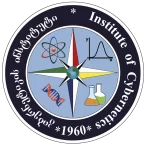Department of Optics and Spectroscopy
Research Areas:
1) Cancer Diagnostics
Conventional cancer diagnostic methods rely on visual observation of suspicious tissue areas. This is followed by invasive tissue biopsy, multistage processing of biopsy material, and tedious subjective microscopic examination. As a result, cancer diagnostics cause significant tissue damage and require substantial human, material, and time resources.
A research group from the Institute of Cybernetics at the Georgian Technical University (Z. Melikishvili, T. Medoidze, and Z. Jaliashvili) is developing an innovative method for detecting biological tissue pathologies, including neoplasms, using laser-induced fluorescence spectroscopy (LIFS). Based on the conducted research, a device called the Laser Canceroscope has been developed (see Fig. 1). The proposed device and technology, which analyze fluorescence spectra induced in biological tissues by nanosecond laser pulses, provide a powerful tool for detecting various pathologies. Notably, this enables cancer diagnosis (see Fig. 2) and subsequent differentiation of cancer types. The device and technology allow: (i) instantaneous detection of tissue pathologies, and (ii) real-time monitoring of suspicious tissue areas during patient examination or surgical procedures. The non-invasive nature of the method is achieved by selecting appropriate laser radiation parameters.

Fig. 1. Laser canceroscope of the Institute of Cybernetics
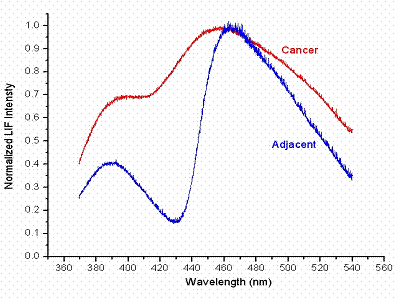
Fig. 2. Fluorescence spectra of cancer and adjacent tissues detected by laser canceroscopy.
2) Light-Controlled Molecular Aggregations in Organic Compounds
Molecular aggregations are promising candidates for applications in information technology, photography, light emitters, and other devices. This phenomenon is currently a subject of intensive scientific research.
Using methods of light-induced optical anisotropy and polarization spectroscopy, our research group is conducting both fundamental and applied studies on light-controlled aggregations. This topic is also being developed within the framework of a grant-funded project by the National Science Foundation.
As an example, Figures 2 and 3 present demonstration images of aggregation photodissociation and photoinduction realized in one of our experiments. The images were captured through a microscope with crossed polarizers. In Figure 2, the darkened ring represents the area of aggregation photodissociation caused by unpolarized light, while the circle indicated by an arrow shows photoinduced aggregations formed by linearly polarized light at the site of dissociation. Unlike spontaneously induced aggregations (see the outermost ring), photoinduced aggregations have uniformly oriented optical axes. This is evidenced by Figure 3, which was captured after rotating the film at a certain angle from the position shown in Figure 2, where this area appears completely darkened
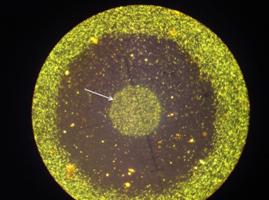
Fig.1
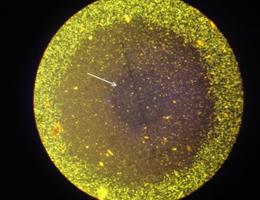
Fig.2
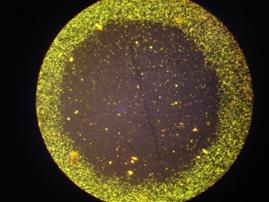
Fig.3
3) Photonics - Photonic Structures
One of the current and promising directions in photonics is the development of photonic structures based on inorganic glass. The potential of this direction is determined by the physical and chemical properties of glass: high uniformity, excellent optical properties, stability of characteristics, the ability to modify glass composition through chemical methods, cost-effective production, and more. A unique property of glass is its ability to be drawn into optical fibers. Particular attention is drawn to the fact that photophysical phenomena in photonic structures fundamentally differ from similar phenomena in conventional materials. Additionally, some optical phenomena in photonic structures have no analogs in classical optics.
A group within the department has created experimental samples of photonic structures, including:
a) An all-optical ultrafast contrast switch for optical imaging (Patent GEO 2006 3965 B)
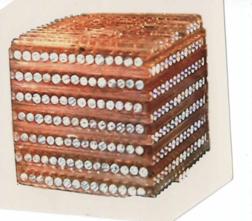
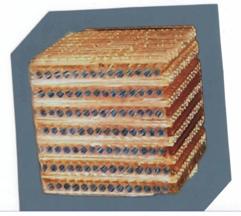
Pictured: All-optical switch
